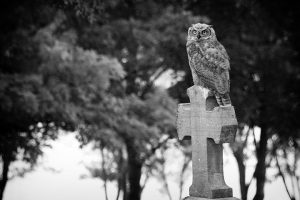The Graveyard School is an appropriate name to describe a group of 15 British poets. These poets were among the first to write about dreary themes such as death and darkness. Sometimes the poets would literally go to a cemetery and write about the depressing moments in their lives. I would give anything to be a fly on a tombstone while these guys were decided what to write next. The Encyclopedia Britannica describes their writings as, “…express[ing] the sorrow and pain of bereavement, evok[ing] the horror of death’s physical manifestations, and suggest[ing] the transitory nature of human life.”
The group started in the 18th century and kicked off the Romantic Movement. Many scholars say that this group of poetry is also responsible for the start of the gothic movement. Because of these writers, dark emotions are now accepted into the realm of poetry. It is believed that most of these poets were Christians. Many of the Graveyard poets used symbolism and other literary devices to capture their relationship with God and their purpose in this world. Many Christian poets think that writing about their God in this dark tone is disrespectful, but these writers are capturing the unknown and doubts about their God through somber writing styles. This new freedom to write about their religion in a pessimistic way allows Christian poetry to be raw and authentic.
There were debatably 15 Graveyard poets, but many of these 15 are not well known. Some of the most famous poets from this time are Edward Young, Robert Blair, Thomas Parnell, and Thomas Grey. Edward Young is considered to be one of the first Graveyard poets. His most famous poem is called “The Complaint: or Night Thoughts on Life, Death, and Immortality.” Young was inspired to write this poem after the death of his wife, stepdaughter, and stepdaughter’s husband. All of these loved ones died within 6 years of each other. Young chooses to write in a blank verse dramatic monologue to capture his perspective of death (because let’s face it, Young has been around a lot of dying people.) He decides to split up the nearly 10,000-lined poem into 9 nights. Having seen death so many times in his family, Young can write about death with many experiences in mind.
Robert Blair is famous for his poem “The Grave.” This poem is also written in blank verse and is 767 lines long. “The Grave” has incredible descriptions of the horrors that come with death. Passages such as, “Again the screech owl shrieks- ungracious sound! I’ll hear no more; it makes one’s blood run chill,” leave the reader uneasy from the vivid descriptions. Many different themes are presented in this poem, but the most prominent theme woven throughout the piece is accepting human mortality. No matter how high up someone rises in life, everyone ends up in the ground – a humbling and depressing perspective on life.
Thomas Parnell is considered have been a genius early on in life. He enrolled in college at thirteen years old and earned a master’s degree at twenty-one. Parnell became depressed after his wife died. His most famous poem, “A Night-Piece on Death,” expresses his feelings that come with depression. This poem’s form is different because it is a simple iambic tetrameter that rhymes in couplets. This poem expresses the hopeless idea that our lives are too short to hold any sort of meaning. In the last few lines, Parnell concludes with the idea that, “On earth, and in the body placed/ A few, and evil, years they waste.”
The Graveyard School is made up of revolutionary poems that started a new literary movement. Some believe that these poets were ahead of their time. Even today, people get uncomfortable reading about the dark sides of life and death, but along with this new style, comes new truths. Many of the Graveyard poets had difficult lives and saw death many times. The Graveyard poems can be a comfort to people who are also looking at death with their own negative experiences. As humans, we try to put complicated concepts we cannot understand into words to simplify the concept. When people can write about the horrors of death and earthly sorrows, then the darkness doesn’t seem so intimidating or frightening. The Graveyard poets were the first to take up this intimidating task by putting their fears on paper. For this reason, their works and innovation will forever be cherished.
Bibliography
“18th Century Poets.” Poet Seers » 18th Century Poets. N.p., n.d. Web. 08 Feb. 2017.
“Graveyard School of Poetry.” Graveyard School of Poetry. N.p., n.d. Web. 29 Jan. 2017.
Huff, James Orton. The Graveyard School of Poets. N.p.: n.p., 1912. Print.
PARISOT, ERIC. “Exhuming The Graveyard School.” Papers On Language & Literature 52.4 (2016): 380-383. MasterFILE Elite. Web. 29 Jan. 2017.
“Pre-Romanticism.” Encyclopædia Britannica. Encyclopædia Britannica, Inc., n.d. Web. 08 Feb. 2017.
Team, The Sheffield Gothic. “”A Night-Piece on Death”.” Sheffield Gothic. N.p., 01 Jan. 1970. Web. 08 Feb. 2017.
The Editors of Encyclopædia Britannica. “Edward Young.” Encyclopædia Britannica. Encyclopædia Britannica, Inc., 20 July 1998. Web. 08 Feb. 2017.
The Editors of Encyclopædia Britannica. “Graveyard School.” Encyclopædia Britannica. Encyclopædia Britannica, Inc., 20 July 1998. Web. 29 Jan. 2017.
The Editors of Encyclopædia Britannica. “Robert Blair.” Encyclopædia Britannica. Encyclopædia Britannica, Inc., 20 July 1998. Web. 08 Feb. 2017.
“The Graveyard Poets [ARTICLE].” DarkestGoth Magazine. N.p., n.d. Web. 29 Jan. 2017.



